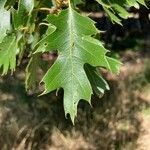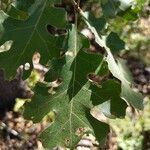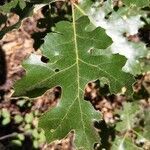Trees , deciduous, to 25 m. Bark dark brown to black, ridges broad, irregular. Twigs brown to red-brown, (1.5-)2-3.5 mm diam., glabrate. Terminal buds chestnut brown, ovoid, 4-10 mm, glabrous or with scales ciliate on margins. Leaves: petiole 10-60 mm, glabrous to densely pubescent. Leaf blade ovate or broadly elliptic to obovate, 60-200 × 40-140 mm, base cordate to obtuse, occasionally rounded, margins with 7-11 lobes and 13-45 awns, lobes acute to distally expanded, separated by deep sinuses, apex acute; surfaces abaxially glabrous with small axillary tufts of tomentum to densely pubescent, adaxially glabrous to minutely pubescent, veins raised on both surfaces. Acorns biennial; cup saucer-shaped to deeply bowl-shaped, 13-27 mm high × 20-28 mm wide, covering 1/2-2/3 nut, outer surface glabrous to sparsely puberulent, inner surface 1/3 to completely pubescent, scales more than 4 mm long, attenuate or acuminate to acute, smooth, occasionally tuberculate near base of cup, tips loose, especially at margin of cup; nut oblong to broadly ellipsoid, 21-34 × 14-22 mm, puberulent, especially at apex, scar diam. 5.5-10.5 mm. 2 n = 24.
More
A large tree. It can grow 18-27 m high and spread 12 m wide. It loses its leaves during the year. It has a large, open, round crown. The bark is thick and cracked into wide ridges. The leaves have deep lobes. There are teeth with bristles along the edge. The leaves are shiny yellow-green above and paler underneath. They can also be hairy underneath. The fruit are acorns on short stalks.
Found in a variety of forest habitats, growing on clay or gravelly soils in hills and mountains; at elevations below 2,500 metres. Sometimes forms groves of considerable extent in coniferous forests.
More
It is a temperate plant. It suits hardiness zones 7-10.




